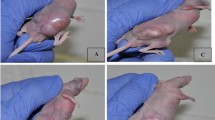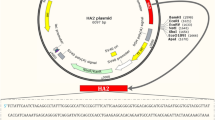Abstract
Background
Immunotherapy is emerging as a major player in the current standard of care for aggressive cancers such as non-small cell lung cancer (NSCLC). The Newcastle disease virus with its tumor-specific replicative and oncolytic abilities is a promising immunotherapeutic candidate. A DNA vaccine expressing the major immunogenic hemagglutinin-neuraminidase (HN) protein of this virus has shown promising results as an immunotherapeutic agent.
Methods
In the present study, three different DNA vaccine constructs encoding differentially targeted HN proteins (cytoplasmic or Cy-HN, secreted or Sc-HN and membrane-anchored or M-HN) were generated to evaluate their anti-tumor effect in vitro and in vivo.
Results
Although all three DNA constructs elicited an immune response, tumor-bearing mice intratumorally injected with M-HN demonstrated a significantly better anti-tumor effect than those injected with Cy-HN or Sc-HN. We also showed that this anti-tumor effect was mediated by higher lymphocyte proliferative response and CTL activity in mice intratumorally injected with M-HN.
Conclusion
The membrane-anchored form of the HN protein appears to be an ideal candidate to develop as an immunotherapeutic agent for NSCLC.







Similar content being viewed by others
References
Parkin DM, Bray F, Ferlay J, Pisani P (2005) Global cancer statistics, 2002. CA Cancer J Clin 55:74–108
Heise C, Hermiston T, Johnson L et al (2000) An adenovirus E1A mutant that demonstrates potent and selective systemic anti-tumoral efficacy. Nat Med 6:1134–1139
Khuri FR, Nemunaitis J, Ganly I et al (2000) A controlled trial of intratumoral ONYX-015, a selectively-replicating adenovirus, in combination with cisplatin and 5-fluorouracil in patients with recurrent head and neck cancer. Nat Med 6:879–885
Nakano K, Todo T, Chijiiwa K, Tanaka M (2001) Therapeutic efficacy of G207, a conditionally replicating herpes simplex virus type 1 mutant, for gallbladder carcinoma in immunocompetent hamsters. Mol Ther 3:431–437
Stojdl DF, Lichty B, Knowles S et al (2000) Exploiting tumor-specific defects in the interferon pathway with a previously unknown oncolytic virus. Nat Med 6:821–825
Yu DC, Chen Y, Seng M, Dilley J, Henderson DR (1999) The addition of adenovirus type 5 region E3 enables calydon virus 787 to eliminate distant prostate tumor xenografts. Cancer Res 59:4200–4203
Herold-Mende C, Karcher J, Dyckhoff G, Schirrmacher V (2005) Antitumor immunization of head and neck squamous cell carcinoma patients with a virus-modified autologous tumor cell vaccine. Adv Otorhinolaryngol 62:173–183
Phuangsab A, Lorence RM, Reichard KW, Peeples ME, Walter RJ (2001) Newcastle disease virus therapy of human tumor xenografts: antitumor effects of local or systemic administration. Cancer Lett 172:27–36
Fu F, Liu C-y, Rui G, Yang B-f, Song C, Li X (2008) Anti-tumor effects of NDV D90 against tumor cells of A549 in vitro. Chin J Prevent Vet Med 30:179–182, 189
Donahue JM, Mullen JT, Tanabe KK (2002) Viral oncolysis. Surg Oncol Clin N Am 11:661–680
Zeng J, Fournier P, Schirrmacher V (2002) Induction of interferon-alpha and tumor necrosis factor-related apoptosis-inducing ligand in human blood mononuclear cells by hemagglutinin-neuraminidase but not F protein of Newcastle disease virus. Virology 297:19–30
Sinkovics JG, Howe CD (1969) Superinfection of tumors with viruses. Experientia 25:733–734
Bian H, Fournier P, Moormann R, Peeters B, Schirrmacher V (2005) Selective gene transfer in vitro to tumor cells via recombinant Newcastle disease virus. Cancer Gene Ther 12:295–303
Janke M, Peeters B, de Leeuw O et al (2007) Recombinant Newcastle disease virus (NDV) with inserted gene coding for GM-CSF as a new vector for cancer immunogene therapy. Gene Ther 14:1639–1649
Zamarin D, Martinez-Sobrido L, Kelly K et al (2009) Enhancement of oncolytic properties of recombinant newcastle disease virus through antagonism of cellular innate immune responses. Mol Ther 17:697–706
Tong T, Fan H, Tan Y et al (2006) C3d enhanced DNA vaccination induced humoral immune response to glycoprotein C of pseudorabies virus. Biochem Biophys Res Commun 347:845–851
Grzelinski M, Steinberg F, Martens T, Czubayko F, Lamszus K, Aigner A (2009) Enhanced antitumorigenic effects in glioblastoma on double targeting of pleiotrophin and its receptor ALK. Neoplasia 11:145–156
Wei L, Dai J, Sun S (2000) Construction of Newcastle disease virus hemagglutinin-neuraminidase (HN) gene and its antitumor immune response effects. Acad J Second Military Med Univ 21:6
Hegde S, Niederkorn JY (2000) The role of cytotoxic T lymphocytes in corneal allograft rejection. Invest Ophthalmol Visual Sci 41:3341–3347
Holt GE, Disis ML (2008) Immune modulation as a therapeutic strategy for non-small-cell lung cancer. Clin Lung Cancer 9(Suppl 1):S13–S19
Cassel WA, Garrett RE (1965) Newcastle disease virus as an antineoplastic agent. Cancer 18:863–868
Schirrmacher V, Haas C, Bonifer R, Ertel C (1997) Virus potentiation of tumor vaccine T-cell stimulatory capacity requires cell surface binding but not infection. Clin Cancer Res 3:1135–1148
Fan H, Xiao S, Tong T et al (2008) Immunogenicity of porcine circovirus type 2 capsid protein targeting to different subcellular compartments. Mol Immunol 45:653–660
Cho JS, Hsu JV, Morrison SL (2009) Localized expression of GITR-L in the tumor microenvironment promotes CD8+ T cell dependent anti-tumor immunity. Cancer Immunol Immunother 58:1057–1069
Klyushnenkova EN, Kouiavskaia DV, Berard CA, Alexander RB (2009) Cutting edge: permissive MHC class II allele changes the pattern of antitumor immune response resulting in failure of tumor rejection. J Immunol 182:1242–1246
Zitvogel L, Mayordomo JI, Tjandrawan T et al (1996) Therapy of murine tumors with tumor peptide-pulsed dendritic cells: dependence on T cells, B7 costimulation, and T helper cell 1-associated cytokines. J Exp Med 183:87–97
Qin Z, Richter G, Schuler T, Ibe S, Cao X, Blankenstein T (1998) B cells inhibit induction of T cell-dependent tumor immunity. Nat Med 4:627–630
Ridge JP, Di Rosa F, Matzinger P (1998) A conditioned dendritic cell can be a temporal bridge between a CD4+ T-helper and a T-killer cell. Nature 393:474–478
Schoenberger SP, Toes RE, van der Voort EI, Offringa R, Melief CJ (1998) T-cell help for cytotoxic T lymphocytes is mediated by CD40–CD40L interactions. Nature 393:480–483
Umeshappa CS, Huang H, Xie Y et al (2009) CD4+ Th-APC with acquired peptide/MHC class I and II complexes stimulate type 1 helper CD4+ and central memory CD8+ T cell responses. J Immunol 182:193–206
Author information
Authors and Affiliations
Corresponding author
Additional information
H. Sui, Y. Bai and X. Li contributed equally to this work.
Rights and permissions
About this article
Cite this article
Sui, H., Bai, Y., Wang, K. et al. The anti-tumor effect of Newcastle disease virus HN protein is influenced by differential subcellular targeting. Cancer Immunol Immunother 59, 989–999 (2010). https://doi.org/10.1007/s00262-010-0821-5
Received:
Accepted:
Published:
Issue Date:
DOI: https://doi.org/10.1007/s00262-010-0821-5




